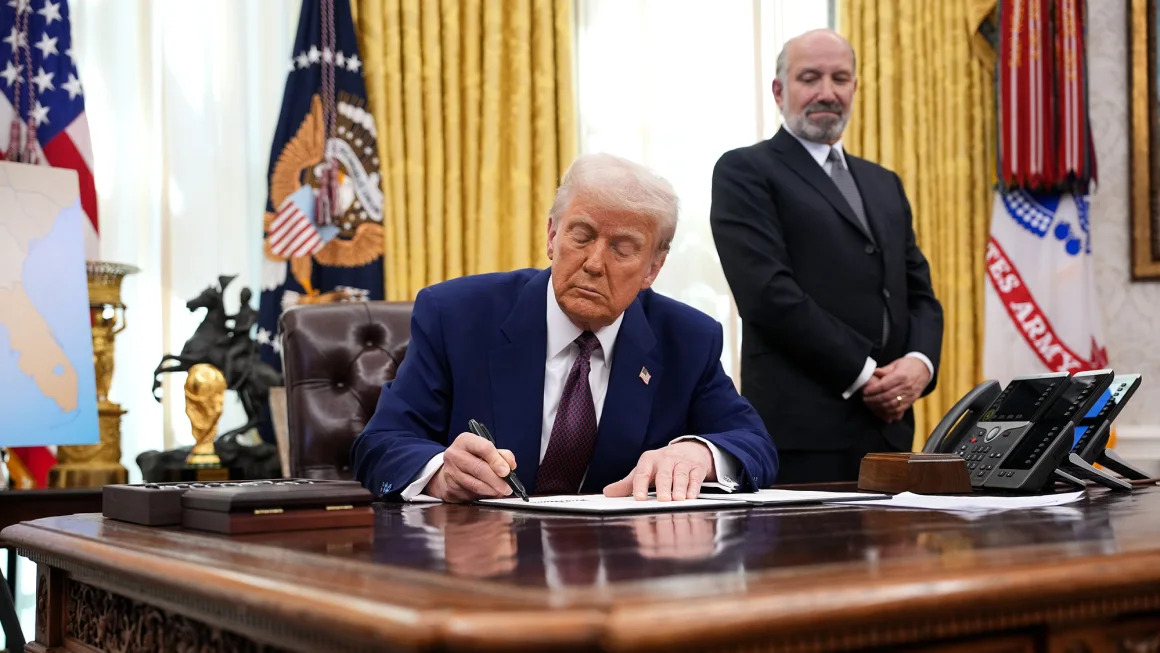Global Markets Brace for Trade Tensions as Trump Expands Tariff Strategy
President Donald Trump has intensified his trade policy stance, ordering federal agencies to draft a plan for new reciprocal tariffs—a move that could reshape global trade relations, further strain inflation, and potentially ignite a trade war.
During a White House ceremony on Thursday, Trump signed an executive order dubbed the “Fair and Reciprocal Plan”, directing officials to assess and implement retaliatory tariffs on nations that impose higher taxes on American goods. He emphasized that the tariffs aim to level the playing field in international trade, reinforcing a core promise of his presidency.
“They charge us a tax or tariff, and we charge them the exact same,” Trump declared in the Oval Office, adding that the administration would factor in value-added taxes (VAT), which he described as “far more punitive than tariffs.”
Commerce Secretary nominee Howard Lutnick confirmed that the tariff review is expected to conclude by April 1, after which Trump could act as early as April 2 to enact the new measures.
Trump particularly singled out India, citing its 100% tariff on American motorcycles, compared to the 2.4% tariff the U.S. places on Indian motorcycles. He suggested that if Indian manufacturers relocate production to U.S. soil, they could avoid tariffs altogether.
“If you build here, you have no tariffs whatsoever,” Trump stated, adding, “I think our country is going to be flooded with jobs.”
The announcement comes just before Trump’s scheduled meeting with Indian Prime Minister Narendra Modi, raising speculation that tariffs may be a negotiation tool in future trade discussions.
Trump’s aggressive tariff strategy has deepened concerns over inflation, which has already been creeping higher in recent months. While tariffs generate revenue for the government, economists warn that they also increase costs for businesses and consumers.
When importers pay higher tariffs, they pass the additional costs to retailers, leading to higher prices for consumers. Critics, including Senate Minority Leader Mitch McConnell, have argued that Trump’s tariffs are effectively a hidden tax on Americans, disproportionately affecting middle-class households.
“If Americans can’t switch to cheaper alternatives, they’ll likely absorb the cost of tariffs,” said Justin Weidner, an economist at Deutsche Bank. “It depends on whether businesses in the supply chain can shoulder the costs—or whether they shift them entirely to consumers.”
According to the Peterson Institute for International Economics, if Trump proceeds with planned 25% tariffs on Mexico and Canada in March, along with existing levies on China, the average U.S. household could face an additional tax burden of over $1,200 per year. The new reciprocal tariffs could further exacerbate these costs.
Despite the looming tariff risks, U.S. stock markets saw a surge on Thursday, with the Dow Jones Industrial Average rising nearly 400 points (0.8%), while the Nasdaq gained 1.3% and the S&P 500 climbed 0.8%.
Analysts suggest that investors remain skeptical about the actual implementation of the tariffs.
“It’s like everything else: He says something with bombast and then dials back,” said Michael Block, a market strategist at Third Seven Advisors. “We fear the worst and then realize it’s all part of the art of the deal.”
Block noted that Trump has a history of announcing tariffs and then delaying them, as seen earlier this month when he postponed levies on Canada and Mexico at the last minute.
Keith Lerner, co-chief investment officer at Truist Wealth, echoed these sentiments, stating that investors believe tariffs will be used as a bargaining chip rather than an immediate policy shift.
“It’s not like tomorrow we’re going to suddenly have 50% tariffs across the board,” Lerner said.
As the White House finalizes its reciprocal tariff strategy, businesses, trade partners, and global markets are bracing for potential economic fallout. Even if tariffs are delayed or softened, their uncertainty alone could deter investment and disrupt supply chains.
For now, Trump remains firm, insisting that his approach will bring fairness and economic prosperity to the United States. Whether that vision materializes—or whether inflation and trade wars escalate—remains to be seen.

